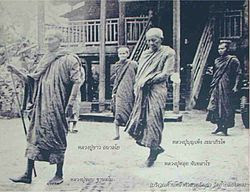Straight from the Heart: Thirteen Talks on the Practice of Meditation by Ven. Ajahn Maha Boowa Ñanasampanno, Ven. Thanissaro; Amber Larson, Dhr. Seven (eds.), Wisdom Quarterly
 |
| Buddhism is about the heart (mind)and the breath (prana or chi) = compassion + wisdom. |
Ajahn Mun taught that all hearts (minds) have the same language. No matter what one's language or nationality, the heart has nothing but simple awareness, which is why he said that all hearts have the same language. When a thought arises, we understand it.
But when we put it into words, it has to become this or that language, so that we don't really understand one another. The feelings within the heart, though, are the same for everyone. This is why the Dharma (Pali Dhamma) fits the heart perfectly. The Dharma isn't any particular language. The Dharma is the language of the heart. The Dharma resides with the heart.
Pleasure and pain reside within the heart. The acts that create pleasure and pain are thought up by the heart. The heart is what knows the results that appear as pleasure and pain, and the heart is burdened with the outcome of its own thoughts. This is why the heart and the Dharma fit perfectly. No matter what our language or nationality, we can all understand the Dharma. It is because the heart and the Dharma are a natural pair.
The heart forms the core within the body. It's the core, the substance, the primary essence within the body. It's the basic foundation. The conditions that arise from the mind, such as thought-formations, appear and vanish again and again.
Here I'm referring to the rippling [
vrittis] of the mind. When the mind ripples, that's the formation of a thought. Labels, which deal with conjecturing, memorizing, and recognizing, are termed
sañña. "Long" thoughts are
sañña; short thoughts are
sankhara. In other words, when a thought forms — "blip" — that's a
sankhara.
Sañña refers to labeling and recognizing.
Viññana refers to the act of taking note when anything external comes and makes contact with the senses, as when visible forms make contact with the eye and cognition results. All of these things are constantly arising and vanishing of their own accord, and so the Buddha called them khandhas (heaps, groups, aggregates). Each "heap" or "group" is called a khandha. These Five Heaps of Khandhas are constantly arising and vanishing all the time.
Even arahants (arhats, enlightened beings)have these same conditions — just like ordinary people everywhere — the only difference being that the arahants' khandhas are khandhas pure and simple, without any defilements giving them orders, making them do this or think that. Instead, their khandhas think out of their own free nature, with nothing forcing them to think this or that, unlike the minds of ordinary people in general.
To make a comparison, the khandhas of ordinary people are like prisoners, constantly being ordered about. Their various thoughts, labels, assumptions, and interpretations have something that orders and forces them to appear, making them think, assume, and interpret in this way or that. In other words, they have defilements as their boss, their leader, ordering them to appear.
 Arahants
Arahants, however, do not. When a thought forms, it simply forms. Once it forms, it simply disappears. There's no seed to continue it, no seed to weigh the mind (heart) down, because there's nothing to force it, unlike the
khandhas governed by defilements or under the leadership of defilements. This is where the difference lies.
But their basic nature is the same: All the khandhas mentioned are inconstant (aniccam). In other words, instability and changeability are a regular part of their nature, beginning with the rupa khandha [form aggregate], our body, and the vedana khandha [feeling or sensation group], feelings of pleasure, pain, and neutrality. These things appear and vanish, again and again. Sañña, sankhara, and viññana are also always in a state of appearing and vanishing as a normal part of their nature.
But as for actual awareness — which forms the basis of our knowledge of the various things that arise and vanish — that does not vanish. We can say that the mind cannot vanish. We can say that the mind cannot arise. A mind that has been purified thus has no more problems concerning the [re]birth and death of the body and the khandhas; thus, there is no more rebirth here and there, appearing in crude forms such as individuals or as living beings, for those whose minds have been purified.
But those whose minds are not purified, they are the ones who take rebirth and die, setting their sights on cemeteries without end, all because of this undying mind.
This is why the Buddha taught the world, and in particular the world of human beings, who know right from wrong, good from evil, who know how to foster the one and remedy the other, who understand the language of the Dharma he taught.

This is why he taught the human world above and beyond the other worlds. It was so that we could try to remedy the things that are harmful and detrimental, removing them from our thoughts, words, and deeds. It was so we could try to nourish and foster whatever goodness we might already have and give rise to whatever goodness we do not yet have.
He taught us to foster and develop the goodness we already have so as to nourish the heart, giving it refreshment and well-being, giving it a standard of quality, or goodness, so that when it leaves its present body to head for whatever place or level of being, this mind that has been constantly nourished with goodness will be a good mind.
Wherever it fares, it will fare well. Wherever it takes rebirth, it will be reborn well. Wherever it lives, it will live well. It will keep on experiencing well-being and happiness until it gains the capacity, the potential, the accumulation of merit it has developed progressively from the past into the present.
In other words, yesterday is today's past, today is tomorrow's past, all of which are days during which we have fostered and developed goodness step by step — to the point where the mind has firm strength and ability, from the supporting power of this goodness, that enables it to pass over and gain release [from rebirth and suffering].
 |
| The forest monastic tradition rediscovered in the 20th century, Isan, Thailand: famous monks |
Such a mind has no more rebirth, not even in the most quiet or refined levels of being that contain any latent traces of conventional reality (sammati) — namely, rebirth and death as we currently experience it. Such a mind goes completely beyond all such things. Here the reference is to the minds of buddhas and arahants.
There's a story about Ven. Vangisa that has a bearing on this. Ven. Vangisa, when he was a layperson, was very talented at divining the level of being at which the mind of a dead person was reborn — no matter who the person was. One ould not quite say he was a fortuneteller. Actually, he was more of a master of psychic skills.
When anyone died, he would take that person's skull and knock on it — knock, knock, knock — focus his mind, and then know that this person was reborn here or there, on this plane or that. If the person was reborn in a hell or a heaven, or as a common animal or hungry ghost, he could tell in every case, without hesitation. All he needed was to knock on the skull.
When he heard his friends say that the Buddha was many times more talented than this, he wanted to expand on his knowledge. So he went into the Buddha's presence to ask for further training in this science. When he reached the Buddha, the Buddha gave him the skull of an
arahant to knock on.

"All right, see if you can tell where he was reborn."
Ven. Vangisa knocked on the skull and listened.
Silence.
He knocked again and listened.
Silence.
He thought for a moment.
Silence.
He focused his mind.
Silence.
He couldn't see where the owner of the skull was reborn. At his wit's end, he confessed frankly that he didn't know where the arahant was reborn.
At first, Ven. Vangisa had thought himself talented and smart and had planned to challenge the Buddha before asking for further training. But when he reached the Buddha, the Buddha gave him the skull of an arahant to knock on — and right then he was stymied. So now he genuinely wanted further training.
Once he had further training, he'd really be something special. This being the way things stood, he asked to study with the Buddha. So the Buddha taught him the science, taught him the method — in other words, the science of the Dharma. Ven. Vangisa practiced and practiced until finally he attained arahantship. From then on he was no longer interested in knocking on anyone's skull except for his own. Once he had known clearly, that was the end of the matter. This is called "knocking on the right skull."
Once the Buddha had brought up the topic of the mind that does not undergo rebirth — the skull of one whose mind is purified — no matter how many times Ven. Vangisa knocked on it, he could not know where the mind was reborn, even though he had been very talented before. For the place of a pure mind's rebirth [since rebirth does not take place] cannot be found.
The same is true in the case of Ven. Godhika. This story should serve as quite some food for thought. Ven. Godhika went to practice meditation, made progress step by step, then regressed. They say this happened six times. After the seventh time, he took a razor to slash his throat. That's how depressed he was — but then he came to his senses, contemplated the Dharma, and became an arahant at the last minute. That's the story in brief.
When he passed into final nirvana, Mara's hordes searched for his "spirit" (gandhabba, relinking consciousness, continuation). To put it simply, they stirred up a storm but couldn't tell where he had been reborn.
So the Buddha said, "No matter how much you dig or search or investigate to find the spirit of our son, Godhika, who has completely finished his task, you won't be able to find it — even if you turn the world upside down. This is because such a task lies beyond the scope of conventional reality." How could they possibly find it? It's beyond the capacity of people with defilements to know the power of an arahant's mind.
In the realm of conventional speech, there is no one who can trace the path of an arahant's mind. This is because an arahant lies beyond convention, even though such a being's mind is just the same. Think about it: Even our stumbling and crawling mind, when it is continually cleansed without stop, without ceasing, without letting perseverance lag, will gradually become more and more refined until it reaches the limits of refinement.
Then the refinement will disappear — because refinement is a matter of conventional reality — revealing a nature of solid gold, or solid Dhrmma, called a pure mind. We, too, will then have no more problems, just like the arahants, because our mind will have become a superlative mind, just like the minds of those who have already gained release from rebirth and suffering.
All minds of this sort are the same, with no distinction between women and men, which is simply a matter of sex or convention. With the mind, there is no distinction between women and men, and thus both women and men have the same capacity in the area of the Dharma.
Both are capable of attaining the various levels of Dharma all the way to final release. There are no restrictions that can be imposed in this area. All that is needed is that we develop enough ability and potential, and then we can all go beyond the beyond.
For this reason, we should all make an effort to train our hearts/minds. At the very least, we should get the mind to attain stillness and peace with any of the meditation themes that can lull it into a state of calm, giving rise to peace and well being within it.
For example, mindfulness of breathing, which is one of the primary themes in meditation, seems to suit the temperaments of more people than any other theme. But whatever the theme, take it as a governing principle, a guide, a mainstay for the mind, putting it into practice within the mind so as to attain rest and peace.
When the mind begins to settle down, we will begin to see its essential nature and worth. We will begin to see what the heart is and how it is. In other words, when the mind gathers all of its currents into a single point, as simple awareness within itself. This is what is called the "mind" (citta).
The gathering [coherence, coming together in harmony and coordination] of the mind occurs on different levels, corresponding to the mind's ability and to the different stages of its refinement.
Even if the mind is still on a crude level, we can nevertheless know it when it gathers inwardly. When the mind becomes more and more refined, we will know its refinement: "This mind is refined... This mind is radiant... This mind is extremely still... This mind is something extremely amazing," more and more, step by step, this very same mind!
In cleansing and training the mind for the sake of stillness, in investigating, probing, and solving the problems of the mind with discernment (pañña, wisdom, understanding) — which is the way of making the mind progress, of enabling us to reach the truth of the mind, step by step, through the means already mentioned — no matter how crude the mind may be, don't worry about it.
If we get down to making the effort and persevere continually with what diligence and persistence we have, that crudeness will gradually fade away and vanish. Refinement will gradually appear through our own actions or our own striving until we are able to go beyond and gain release by slashing the defilements to bits. This holds true for all of us, men and women alike.
But while we aren't yet able to do so, we nevertheless should not be anxious. All that is asked is that we make the mind principled so that it can be a guide and a mainstay for itself. As for this body, we've been relying on it ever since the day we were reborn. This is something we all know. We've made it live, lie down, urinate, defecate, work, earn a living. We've used it, and it has used us. We order it around, and it orders us around.
For instance, we've made it work, and it has made us suffer with aches here and pains there so that we have to search for medicine to relieve it. It's the one that hurts, and it's the one that searches for medicine. It's the one that provides the means. And so we keep supporting each other back and forth in this way.
It's hard to tell who is in charge, the body or us. We can order it around part of the time, but it orders us around all of the time. Illness, hunger, thirst, sleepiness, these are nothing but a heap of suffering and distress in which the body orders us around from every side. We can order it around only a little bit. So when the time is right for us to give the orders, we should make it meditate.
So get to work. As long as the body is functioning normally, then no matter how much or how heavy the work, get right to it. But if the body isn't functioning normally, if you're ill, you need to be conscious of what it can take. As for the mind, however, keep up the effort within, unflaggingly, because it's your essential duty.
You've depended on the body for a long time. Now that it's wearing down, know that it's wearing down — which parts still work, which parts no longer work. You're the one in charge, and you know it full well, so make whatever compromises you should.
But as for the heart, which isn't ill along with the body, it should step up its efforts within so that it won't lack the benefits it can gain.
Make the mind have standards and be principled — principled in its living, principled in its dying. Wherever it's reborn, make it have good principles and satisfactory standards. What they call "merit" (puñña) will not betray our hopes and expectations.
It will provide us with satisfactory circumstances at all times, in keeping with the fact that we've accumulated the merit — the well being — that all the world wants and of which no one has enough. In other words, what the world wants is well being, whatever the sort, and in particular the well-being of the mind that will arise step by step from having done things, such as meditation, which are noble, virtuous, and good.
This is the well being that forms a core or an important essence within the heart. We can strive, then, while the body is still functioning, for when life comes to an end, nothing more can be done. No matter how little or how much we have accomplished, we must stop at that point. We stop our work, put it aside, and then reap its rewards and consequences — there, in the next life.
Whatever we are capable of doing, we do. If we can go beyond or gain release from suffering and rebirth, that's the end of every problem. There will then be nothing to involve us in any further turmoil.
Here I've been talking about the mind because the mind is the primary issue. That which will make us fare well or ill, meet with pleasure or pain, is nothing but the mind.
As for what they call bad karma, it lies within the mind that has made it. Whether or not we can remember, these seeds — which lie in the heart — cannot be prevented from bearing fruit. This is because they are rooted in the mind. We have to accept our karma. Don't find fault with it. Once it's done, it's done, so how can we find fault with it? The hand writes, and so the hand must erase. We have to accept it like a good sport. This is the way it is with karma until we can gain release — which will be the end of the problem.
More
 (The History Channel) The true origins and "The Real Story of Halloween" or All Hallows' Eve
(The History Channel) The true origins and "The Real Story of Halloween" or All Hallows' Eve Waking up in white suburbia -- Pasadena, California -- on Halloween/Samhain* looking for adventure means a quick trip to Alexandria II (Alexandria I is in Egypt and too far). It is the east valley's own Bodhi Tree Bookstore for local witches.
Waking up in white suburbia -- Pasadena, California -- on Halloween/Samhain* looking for adventure means a quick trip to Alexandria II (Alexandria I is in Egypt and too far). It is the east valley's own Bodhi Tree Bookstore for local witches. When we reach the limit of the road, we begin to hike to Echo Mountain. It's overcast and about to rain, which is strange after searing days of 100 degrees. The Dead (petas or pretas, remembered in the Buddhist texts known as the Petavatthu or "Ghost Stories") are preparing to cross the veil. They're there, not easily visible composed only of prana, air, and light (karma-born "spontaneous" devic/preta bodies). They're not really "dead," only gone from here, transitioned, transformed, but here to make contact, to be remembered. We miss them, so we still care for them.
When we reach the limit of the road, we begin to hike to Echo Mountain. It's overcast and about to rain, which is strange after searing days of 100 degrees. The Dead (petas or pretas, remembered in the Buddhist texts known as the Petavatthu or "Ghost Stories") are preparing to cross the veil. They're there, not easily visible composed only of prana, air, and light (karma-born "spontaneous" devic/preta bodies). They're not really "dead," only gone from here, transitioned, transformed, but here to make contact, to be remembered. We miss them, so we still care for them.













 .
.
































































































































































































































































